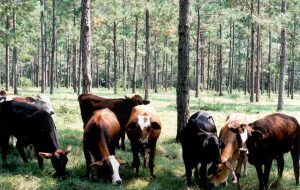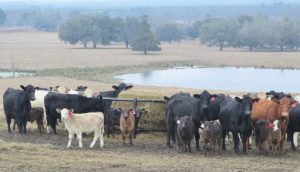Snow and ice are things that Florida livestock owners typically do not have to deal with. But even with most livestock being adapted to cold weather, the severe dip in temperatures this week can potentially cause problems for livestock and owners alike. The following are some common tips to ensure that livestock remains healthy and safe during these winter weather fluctuations.
SHELTER

Most livestock can handle wind chills above 20°F with little stress, but once you add cold wet weather and excessive winds, even they will need a safe area for protection. Trees and other natural barriers will provide wind breaks, but animals should have access to a three-sides shelter. Enough space should be provided to lie down safely and dry, clean bedding will help insulate livestock from the effects of cold temperatures and ground moisture. If no constructed shelter is available, evergreens or other trees that do not lose their leaves in the winter can be used. Blankets can be used to cover individual animals. However, if the blankets get wet, they should be replaced with dry ones to keep the animals coats dry.
FEED

Livestock nutritional requirements can drastically increase during cold weather due to the increased work in maintaining body heat and shivering, which metabolically requires more energy. Some livestock producers will provide more grain during the winter time, but the fermentation of fiber (grass or hay) is what creates body heat by releasing energy. Good quality hay should be provided during these cold and wet times to produce and maintain livestock body heat. Minimize the amount your animals need to move around the pastures from water source to hay or grazable forage, as this can expend precious energy they need to maintain their health. Failing to provide enough nutrition for animals in the winter may result in stunted animals, poor milk production, or other livestock issues.
WATER
The chances of water troughs freezing in our region are very slim to none, but troughs should be checked often, and an ample supply of water should be provided for all livestock. Water consumption may increase during cold and wet weather, and it is essential that all livestock have a clean and fresh supply of water.
BODY CONDITION SCORING
Utilize Body Condition Scoring (BCS) to assess the overall fat cover of cattle to use as an indicator through the cold seasons of animals who may not be taking in enough feed. BCS uses a nine-point scoring system to measure the body fate reserves of an animal. Typically, a score of 5-7 is suitable, with lower numbers being categorized as weak and thin and larger numbers above 7 being fat or over-weight. Livestock that have good body condition can handle winter weather or extreme conditions better than weaker animals.
As livestock owners, we want to optimize the performance of our animals, but also provide the care that prevents the discomfort of the elements and prevents poor nutrition. With the next couple of days under hard freeze warnings for much of Northeast Florida, providing adequate shelter, feed, and water will help prevent any hardships to your animals and you. For further information on winter livestock management, please read the following:
10-Point Plan for Winter Feeding Beef Cattle
Implications of Body Condition Score on Productivity
 0
0
